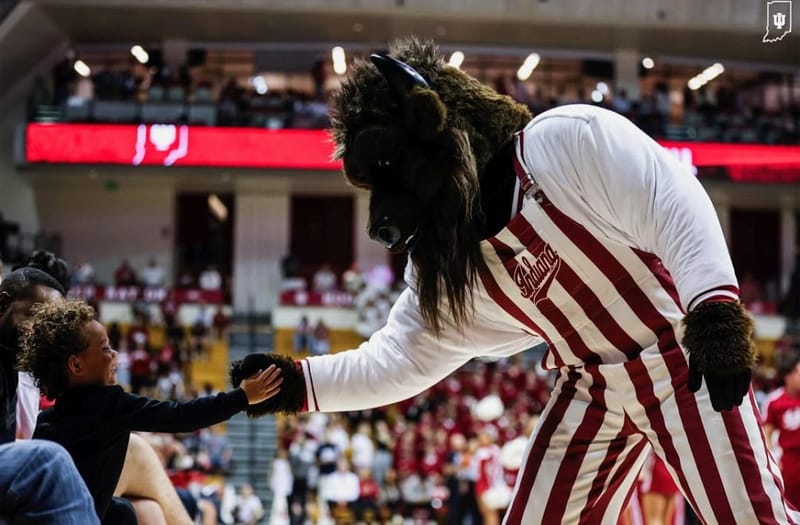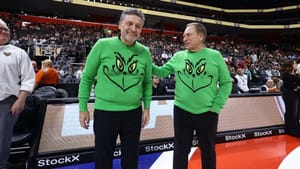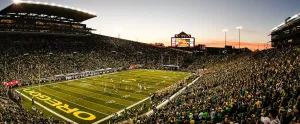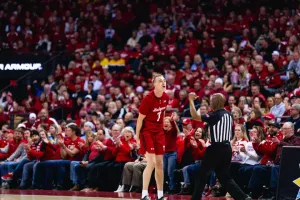B1G Basketball Previews: Indiana Hoosiers
You look tall enough to play in the Big Ten. Come start for us

Last Season’s Recap
Mike Woodson’s squad entered year 4 with preseason expectations of competing for a Big Ten title and with some luck perhaps nationally (ranked #17 in the preseason AP poll). Those expectations disappeared following a disastrous trip to the Bahamas. The Hoosiers were blown out by resurgent Louisville and then lost to Gonzaga before managing a 16-point win over Providence to secure 7th place in the Battle 4 Atlantis. There were no other non-conference hiccups, but the slate wasn’t the most challenging to begin with either.
A soft start to Big Ten play with three home games and a “neutral site” game in the first five saw Indiana rebound to a 13-3 (4-1) record by early January. Then the wheels came off the bus. Indiana would lose seven of their next eight games. Support within the Hoosiers fanbase for the coaching staff plummeted. Louisville and Michigan had turned around their programs in year 1, but in year 4 Indiana was headed for a second consecutive rejection by the tournament committee.
Amid swirling rumors about whether Indiana’s AD would fire Mike Woodson, Woodson announced the day before the Michigan home game (which ended up being the final loss in that stretch) that he would not be returning next season. This placed Michigan head coach (and Indiana alumni) Dusty May in an awkward position during the post-game press conference.
The Hoosiers would rebound somewhat down the stretch winning at conference leader Michigan State and defeating rival Purdue in a 15 point blowout. Despite the ugly stretch of play in January, they managed a 10-10 Big Ten record. An uninspiring loss to Oregon in their first Big Ten tournament game left Indiana on the outside of the bubble when the Selection Committee made their picks known.
A dismal 32.1% three-point shooting number crippled Indiana’s offense. While the defense was respectable, neither it nor Oumar Ballo’s post scoring was enough to make up for the lack of scoring punch. Junior Malik Reneau repeatedly battled foul trouble, Mackenzie Mgbako’s breakout year never quite materialized, and incoming transfer outside shooters couldn’t hit the broad side of a barn. Perhaps most concerning was that nobody other than Luke Goode seemed to care. However, last season’s results shouldn’t weigh on this year’s team. It’s a complete overhaul of the program from coaching staff to roster.
Departures
Everybody left. I could talk about where they all ended up but let's be honest, nobody cares.
Projected starters
6’3” PG – Tayton Conerway (Troy). Conerway helped lead the Trojans to Sun Belt tournament title as their leading scorer. He’s an above average distributer (4.8 assists per game) and an excellent on ball defender that looks to pick the pocket of his opponents. With the lack of rim protection on the roster, Conerway will have to help anchor Indiana’s defense on the perimeter.
6’5” SG – Lamar Wilkerson (Sam Houston). Wilkerson was 13th in the nation with 20.5 points per game last season. He got there with a 44.5% three point percentage and deep range. Opponents have to pick him up as he crosses the halfcourt line. Indiana hired Sam Houston State associate head coach as director of player personnel to help nab Wilkerson’s commitment over Kentucky.
6’6” SF – Jasai Miles (North Florida). Miles was the leading scorer for North Florida this past season averaging 15.4 points per game. He wasn’t super-efficient getting there (33% from three, 42.5% overall) but as the non #1 option, Hoosier fans will hope those numbers improve with better shot selection. Enright could start instead which would move Wilkerson down to the 3 spot.
6’7” PF –Tucker DeVries (Drake, West Virginia). The son of head coach Darian, Tucker was the MVC player of the year in 2023 and 2024. Following an early season shoulder injury Tucker missed most of last season at West Virginia which contributed to them finishing just outside of the NCAA tournament field. Assuming he returns to full health, DeVries is clearly Indiana’s best player. A career 36.5% three point shooter, DeVries is comfortable being the focal point of an offense.
6’10” C - Reed Bailey (Davidson). For much of the summer, Bailey was the tallest man on the roster. Although that’s no longer true, he’s still very much the favorite to win the starting center role due to a lack of major competition for playing time at the position. Bailey is a pretty good scorer and led the Davidson offense with 18.8 points per game. He can step out and shoot the three and even went 41.5% from deep on just over 1 attempt per game this past season. Bailey doesn’t have great rebounding numbers which will likely be a concern after transferring from the A10 to the B1G.
Bench
6’2” G - Conor Enright (Drake, DePaul). Did better at Drake than last season at DePaul. Shooting percentages dropped from excellent to poor and turnover rate climbed. Did a much better job dishing out assists. A torn labrum in January caused him to miss a little under half of the season. Likely backup PG, but could compete for the starting job.
6’2” G Jason Drake (Drexel). Drake is a shooter. He went 39.6% from three for Drexel last year. Doesn’t do much else but should be a good SG/SF backup off the bench.
6’2” G – Aleksa Ristic (Serbia). The 20 year old freshman played professionally in Serbia. I’m not going to pretend to know how that translates to college ball in the US, but Ristic was also a solid member of the Serbia U20 team this summer.
6’7” F - Nick Dorn (Elon). Stronger playing away from the rim, his game is more of that of a big guard than a forward. Above average three point shooter (career 35%). Able to draw fouls at a high rate against CAA competition, but didn’t translate in limited games against P5 teams. Missed the end of the season with a lower extremity injury and has dealt with some injuries over the course of the summer. If he’s able to get healthy, could slot into the starting lineup at the PF position and slide DeVries to the SF.
6’8” F - Josh Harris (North Florida) Ability to score in the paint and rebounded well. Was the starting center for the Ospreys as a freshman but will be undersized at this level.
6’8” F - Sam Alexis (Chattanooga, Florida) Saw playing time plummet after transferring into Florida last year. At Chattanogga, was an excellent rebounder and good post scorer. Struggles with free throws.
6’11” C – Andrej Acimovic (Bosnia) – Another European. Acimovic is the lone center on the roster. Despite that he is likely to be low on the depth chart this season and projects as a project.
6’8” F - Trent Sisley (4 star recruit). Solid two way player. Has the size to play the PF position. Not an elite athlete, but has good instincts that makes his abilities play up. Three point shooting is his best attribute – which this is the wrong roster for that to get him early playing time. Could see playing time but the glut of more experienced 6’7” to 6’8” players on the roster may see him relegated to the bench.
Overview:
I project Indiana to play small ball. The goal will be to stretch out opposing defenses and rain down three point attempts. With the lack of physical size on the roster that's almost certainly the way things will shake out. There are a lot of former leading scorers on this roster so some players will have to accept reduced roles for things to work out. Dorn, Ristic, Drake, and Harris are all dealing with various injuries with Ristic and Drake are unlikely to be ready by the start of the season.
Indiana looks to have an above average three point shooting team and that’s what they will need to leverage to compete against the top of the Big Ten. A distinct lack of size in the post means they could struggle to rebound or defend against bruising centers so they will need to outscore some opponents. The length of their guards and wings will hopefully help disrupt passing lanes and pressure by Conerway should create some easy fast break opportunities. If the defense and rebounding can hold their own, Indiana’s shooting should help them cause some upsets that make up for unexpected losses on off shooting nights. The depth of scoring options should also help them if one of DeVries or Wilkerson is cold on any given night.
This doesn’t look like a roster that should compete for a conference title, but they have enough pieces to be in the running for a NCAA tournament bid. At the very least, DeVries style of play will be a welcome look for Hoosier fans following Woodson’s stagnant offensive principles.
BuffKomodo: The DeVries era in Bloomington is, if nothing else, going to be a total departure from the Archie Miller/Mike Woodson tenures. Much of that means aesthetically pleasing basketball, some of that early probably means struggling to break through into the top half of the B1G during the first year or two of DeVries tenure. Does that mean Indiana won’t make tournaments or find success? No. No it doesn’t. It just means don’t expect this team this year to compete for a conference title this year.
This Hoosier team will be smaller and undersized but will look to play effective small ball by pushing the tempo early and getting shots they want, namely 3’s or layups in transition or off rips. Gone are the days of monotonous post ups and clunky iso ball. Looks for more flow in the offense and an urge to shoot it from deep.
Of course that brings its own problems, namely being beaten up in the B1G. If the 3’s aren’t falling, Indiana could get into some ugly games. What’s going to really tell the tale of the season will be how the guards perform on defense. If they can produce enough pressure to disrupt offenses and make it challenging to go inside for some of these bigger teams, it could pan out. Otherwise, better make plenty of 3’s.
Overall, Indiana should find itself in a bubble watch position come March if things go well. If not, well I guess this dusty banner program can afford one year of meh results before the pitchforks come.As for me, I am more optimistic now than I was after the Woodson hire, so there’s that.




